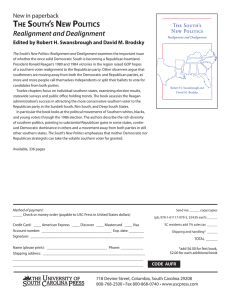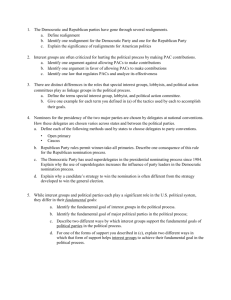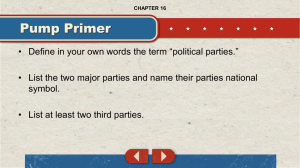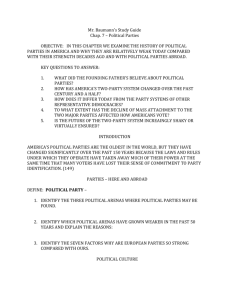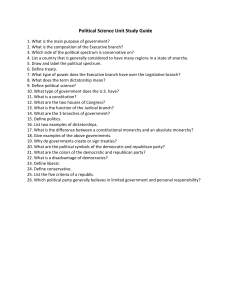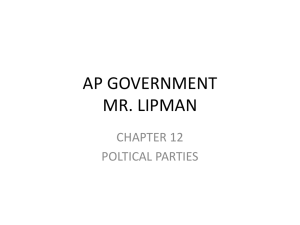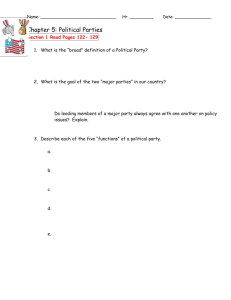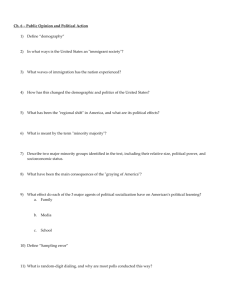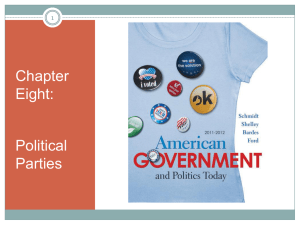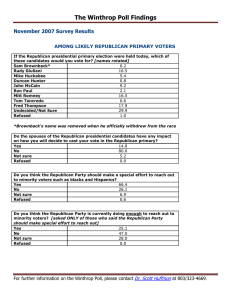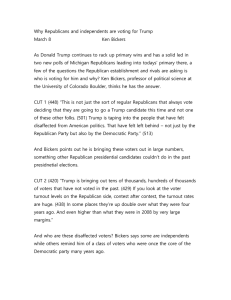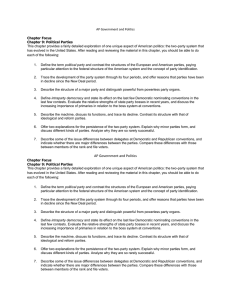Wilson Ch. 9 - Political Parties
advertisement
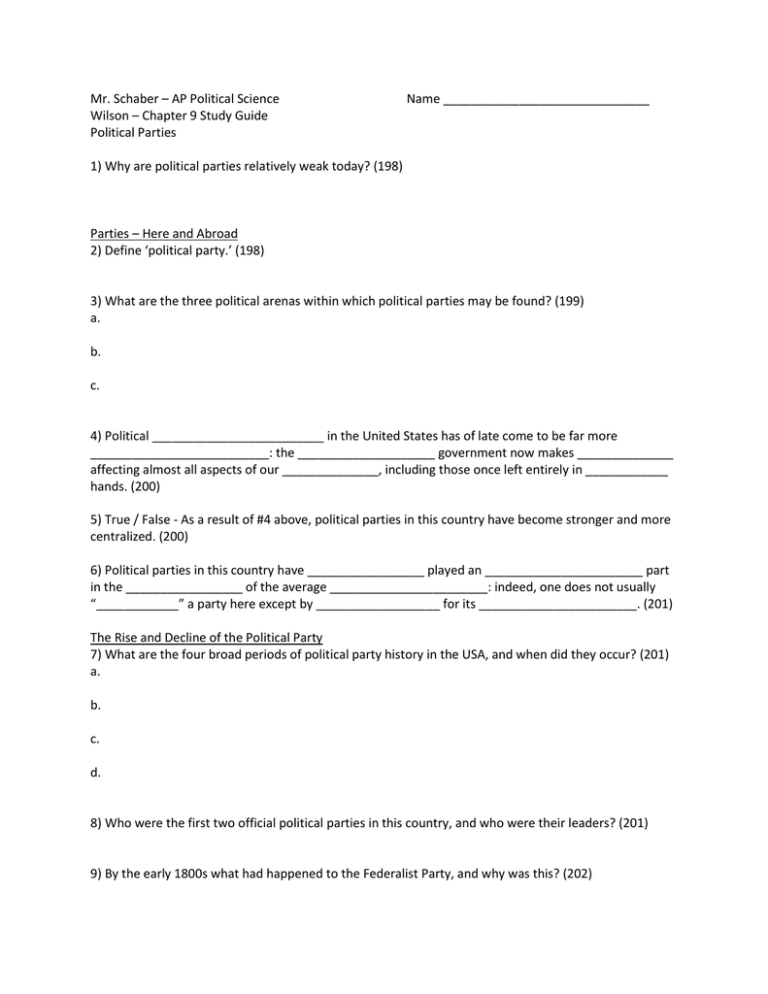
Mr. Schaber – AP Political Science Wilson – Chapter 9 Study Guide Political Parties Name ______________________________ 1) Why are political parties relatively weak today? (198) Parties – Here and Abroad 2) Define ‘political party.’ (198) 3) What are the three political arenas within which political parties may be found? (199) a. b. c. 4) Political _________________________ in the United States has of late come to be far more __________________________: the ____________________ government now makes ______________ affecting almost all aspects of our ______________, including those once left entirely in ____________ hands. (200) 5) True / False - As a result of #4 above, political parties in this country have become stronger and more centralized. (200) 6) Political parties in this country have _________________ played an _______________________ part in the _________________ of the average _______________________: indeed, one does not usually “____________” a party here except by __________________ for its _______________________. (201) The Rise and Decline of the Political Party 7) What are the four broad periods of political party history in the USA, and when did they occur? (201) a. b. c. d. 8) Who were the first two official political parties in this country, and who were their leaders? (201) 9) By the early 1800s what had happened to the Federalist Party, and why was this? (202) 10) The parties that existed in the early years of the nation were essentially ________________ groups of ______________ notables. Political participation was ____________________, and __________________________ for most ______________ offices were arranged rather casually. (202) 11) What is meant by the ‘second party system’ (when, who, distinctive feature)? (202) 12) During the second party system _______________________ politics became a truly _____________, genuinely popular activity. Thus, the party system of the Jacksonian Era was built from the ___________ up rather than from the ____________ down. (202) 13) What was started to replace the caucus system (of nominating presidential candidates)? (203) 14) How did the modern Republican Party start, and what did it become as a result of the Civil War? (203) 15) The Civil War caused a major rift in Americans’ political identification – for generations those who supported the Union side became ___________________________, while those who supported the Confederacy became __________________________. (203) 16) From 1896 to the 1930s, with rare exceptions, with which political party did the following areas identify themselves? *Northern states – *Southern states – 17) What types of political reforms were favored by the ‘progressive’ faction of the Republican Party in the early 1900s? (204) 18) What are the two main kinds of political party realignment? (205) (1) (2) 19) Give the reasons for major political realignments at the following times in US history: (205-206) *1860 – *1896 – *1932 – 20) In short, an electoral realignment occurs when a new _______________ of utmost importance to the _________________ cuts across existing _________________ divisions and replaces old issues that were formerly the _________________ of party ____________________________. (206) 21) What are a couple pieces of evidence that the major political parties are decaying? (207) 22) Define ‘split ticket.’ (207) 23) Define ‘straight ticket.’ (207) The National Party Structure Today 24) Who holds ultimate authority in the Democratic and Republican parties? How often do they meet? What is their job? (208) 25) What is a national committee, and who comprises it? (208) 26) What does the congressional campaign committee do? (208) 27) Who is the national chairman, and what does he/she do? (208) 28) In 2004 both Republicans and Democrats worked hard to raise ‘soft money’ – what is that? (209) 29) Who are superdelegates? What role do they play in elections? (211) 30) The national party conventions are no longer places where party _______________meet to bargain over the selection of their presidential ________________________; they are instead places where delegates come together to ________________ choices already made by party ___________________ and primary ____________________. (212) State and Local Parties 31) In every state there is a Democratic and a Republican state party organized under _____________ law. (213) 32) What is a political machine? (213) 33) What did political party machines do for immigrants as they began flooding into eastern cities in the late 1800s? (213) 34) What happened to political machines as voters eventually grew in education, income, and sophistication? (214) 35) True / False – The old style political machine is still very much alive and thriving? (214) 36) At the opposite extreme from the machine is the ideological party – what is that? (215) 37) The strongest ideological parties have been independent “_________________ parties.” (215) 38) In the 1950s and 1960s many ideological groups were “_________________ clubs,” while in the 1960s and 1970s they became more focused ___________________ movements. (215) 39) What is often the motivation for people who participate in state and local politics? (215) 40) What is the advantage of local political groups? What is the disadvantage? (216) 41) In today’s politics, many politicians seek to form a personal following. What does this mean? (216) 42) What must a candidate have in order to form a good personal following? (216) 43) Define ‘two-party system.’ (217) 44) True / False – Overall in the world, a two-party system is rare. (217) 45) Define ‘plurality system.’ (217) 46) What is the most dramatic example of the winner-take-all system in the United States? (218) 47) Only one third party has ever won the presidency in the US – who, and when, was it? (219) Minor Parties 48) The electoral system may prevent ______________ parties from __________________, but it does not prevent them from ____________________. (220) 49) The minor parties that have endured have been the ______________________ ones. (220) 50) Name the 4 major types of minor parties, and give an example of each. (See box on pg. 221) (1) (2) (3) (4) 51) The impact of minor parties on American politics is _____________ to ________________. One bit of conventional wisdom holds that minor parties develop _________________ that the major parties later come to __________________. (222) 52) What type of minor parties has probably had the greatest influence on public policy? (223) Nominating a President 53) What are the two contrary forces that major parties face? (223) (1) (2) 54) True / False – Most delegates to a party’s nominating convention have the same policy views as most voters and party supporters. (224) 55) Explain how primary elections are different from caucuses. (225 and G5 in Glossary) 56) In today’s politics, a large proportion of convention delegates, both Republican and Democratic, are _______________ - oriented _____________________. (225) Parties Versus Voters 57) Even without a scandal, recession, or some other unifying issue, the need to win an election will lead all candidates to move where? Why do they do this? (226)
